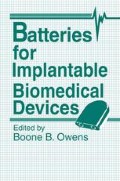Abstract
The function of a battery is to supply electrical energy at a rate sufficient to power the device it drives. Since power is the product of current and terminal voltage, the ideal battery performance model will project these quantities mathematically over the entire range of conditions likely to be encountered in the lifetime of the battery. The first use of a model then is to project how long a new battery will last under a known set of application conditions. If the model is very complete, it serves a second purpose: to project the amount of useful life left in a battery after it has been partially discharged. For an implanted medical device, this information could be a key element in planning for surgical replacement procedures.
Access this chapter
Tax calculation will be finalised at checkout
Purchases are for personal use only
Preview
Unable to display preview. Download preview PDF.
References
J. B. Phipps, T. S. Hayes, P. M. Skarstad, and D. F. Untereker, Extended Abstracts 84–2, Abstract 175, pp. 258, The Electrochemical Society, Pennington, New Jersey (1984).
K. Fester, W. Helgeson, B. Owens, and P. Skarstad, Solid State Ionics 9&10, 107 (1983).
D. F. Untereker, J. Electrochem. Soc. 725(12), 1097 (1978).
H. F. Gibbard, in: Power Sources for Biomedical Implantable Applications and Ambient Temperature Lithium Batteries (B. B. Owens and N. Margalit, eds.), Vol. 80–4, pp. 510, The Electrochemical Society, Princeton, New Jersey (1980).
K. R. Brennen, K. E. Fester, B. B. Owens, D. F. Untereker, J. Power Sources 5, 25 (1980).
B. B. Owens, Stimeucoeur Med. 9, 161 (1981).
R. Dutcher, Medtronic, Inc., internal communication, unpublished.
B. D. Goldman and V. Parsonnet, PACE 2(5), (1979).
J. S. Kim, Medtronic, Inc., internal communication, unpublished.
Author information
Authors and Affiliations
Editor information
Editors and Affiliations
Rights and permissions
Copyright information
© 1986 Plenum Press, New York
About this chapter
Cite this chapter
Brennen, K.R., Kim, J.S. (1986). Battery Performance Modeling. In: Owens, B.B. (eds) Batteries for Implantable Biomedical Devices. Springer, Boston, MA. https://doi.org/10.1007/978-1-4684-9045-9_5
Download citation
DOI: https://doi.org/10.1007/978-1-4684-9045-9_5
Publisher Name: Springer, Boston, MA
Print ISBN: 978-1-4684-9047-3
Online ISBN: 978-1-4684-9045-9
eBook Packages: Springer Book Archive

